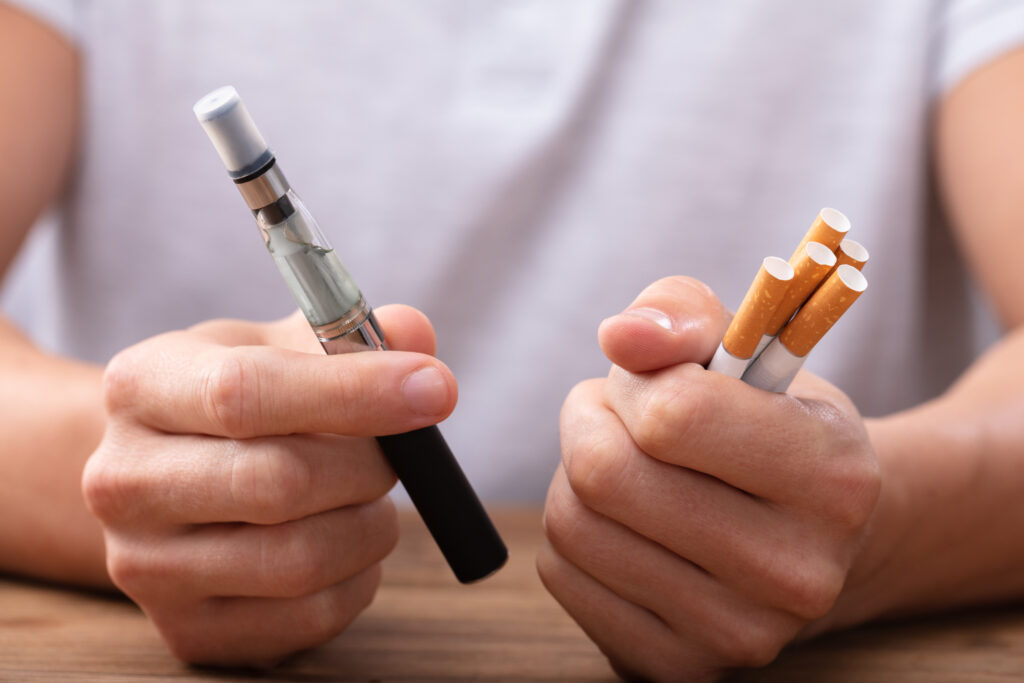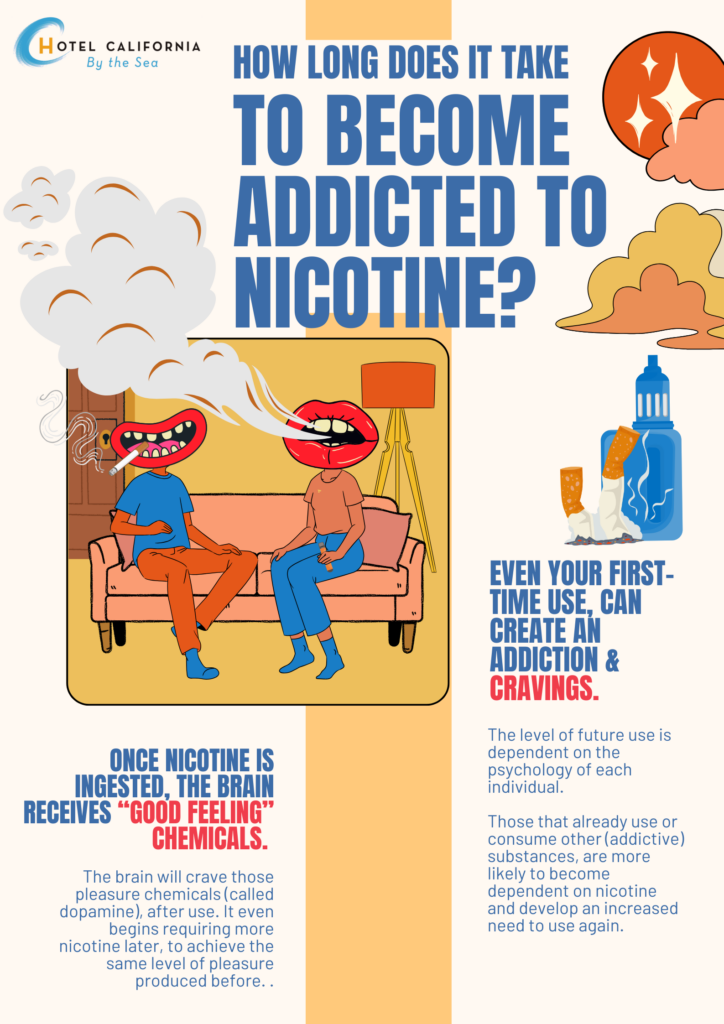How long does it take to get Addicted to Nicotine?
Nicotine is a type of stimulant substance most often found in tobacco products like cigarettes, cigars and vape pens. Nicotine is a highly addictive substance and contributes to nicotine addiction with direct links to cancer. The rate at which a person can show signs of nicotine dependence and addiction will vary from person to person. On January 15, 2025, the FDA announced a proposed rule that would require the tobacco industry to lower nicotine levels in cigarettes. The idea originated during the first Trump administration and then pushed again by the Biden administration and anti-smoking advocates who want to limit nicotine in cigarettes and other combustible tobacco products to make them less addictive and easier to quit.

Per year, cigarette smoking is estimated to cause more than 48,000 deaths in the US. This includes exposure to secondhand smoke. Research finds that nicotine and tobacco abuse is the leading preventable cause of death nationally. Nicotine dependence occurs when the body gets accustomed to having a certain level of nicotine in the system.
The recent proposal to reevaluate nicotine levels is meant to reduce the addictiveness of cigarettes, which are some of the deadliest consumer products currently on the market. The assistant vice president of national advocacy at the American Lung Association said capping the amount of nicotine allowed in cigarettes to very low or non-addictive levels could have a significant impact on the popularity of smoking. It could make smoking cigarettes easier to quit and result in fewer young people who start off experimenting and will be less likely to become addicted adult smokers.
What is Nicotine Addiction?
Nicotine is a highly addictive substance and can change the body and alter brain functions. Nicotine works by activating the brain’s reward pathways. It takes less than 10 seconds for nicotine to reach the brain after it has been inhaled. This floods the brain with neurochemicals such as dopamine and produces feelings of pleasure. Nicotine can produce both physical and psychological dependence.
Physical dependence is when the body needs nicotine in order to avoid experiencing withdrawal symptoms. Nicotine withdrawal can last anywhere between 1-4 weeks. Psychological dependence occurs when the user feels like they cannot get through the day without the presence of nicotine in their body. The effects of nicotine are very short-lived because you get an initial mood boost that will then wear off within 1 or 2 hours.

Common side effects of Nicotine Addiction
- Increased blood pressure
- Increased heart rate
- A rush of adrenaline
- Chest tightness
- Difficulty sleeping
- Dizziness
- Headache
- Increased hunger and weight gain
- Nasal drip
- Nausea
- Feeling jittery and agitated
- Fatigue
- Difficulty focusing
- Anxiety and depression
- Cancer
- Stroke
- Respiratory diseases
What are the current levels of Nicotine in Cigarettes and Vape products?
While there is currently no limit on the level of nicotine exposure that applies to every person who can become addicted, this begs the question of what level of nicotine reduction can prevent smokers from becoming addicted and what level of nicotine reduction can help established smokers readily control or quit their use. Currently most manufactured cigarettes contain around 10mg-15mg of nicotine per cigarette. On average, smokers will absorb about 10% of the nicotine contained in each cigarette. When it comes to vape pens and e-cigarette devices, the levels of nicotine vary depending on the brand. It is difficult to say exactly how much nicotine is contained in these combustion products.
How long does it take to get addicted to Nicotine?
Because there is no set limit in which a person can develop an addiction, how long it takes a person to become addicted to nicotine will vary per individual. However, studies have shown that nicotine can be just as addictive as alcohol and dependence and addiction can develop as soon as one or two uses of the substance.
People who begin using nicotine before the age of 20, are more likely to develop an addiction later on in life and are less likely to quit. Vaping or use of e-cigarettes is the most popular form of nicotine and tobacco intake among young people and young adults. Studies found that an estimated 1 in 10 high school students reported using a vape within the past 30 days. Because nicotine can impact brain development, especially in younger users, an addiction can develop early on and into adulthood.
Check Your Insurance Coverage for FREE
Find out if your insurance covers addiction treatment in minutes. We accept most insurance!
Statistics on Cigarette Use and Nicotine Exposure
- Cigarettes contain about 600 ingredients, which when burned can produce over 7,000 chemicals with 69 of those chemicals directly linked to causing cancer
- In about 70% of countries, 31 million adult smokers say they would rather not smoke
- Only about 7.5% of adult smokers can actually quit each year
- According to the CDC, in 2020, 13 out of 100 adults in the US smoked cigarettes
- The US has one of the highest rates of death from lung cancer associated with nicotine use
- Cigarette smoke has been on a slow decline since the late 1990s
New regulations on lowering nicotine levels in Nicotine containing products
According to FDA research, lowering nicotine to minimally addictive or nonaddictive levels in cigarettes could help an estimated 12.9 million people quit smoking within the first year. The agency says there is significant evidence that supports the move would dramatically reduce smoking and half a million smoking-related deaths each year. Advocates say establishing a nicotine level standard can profoundly alter the trajectory of tobacco use in the country making it less addictive and less likely a person will suffer health consequences from abuse of the substance. The general aim of the nicotine reduction policy is to make cigarettes nonaddictive so users can be free to consider the benefits versus the risks of smoking or not smoking.
The Family Smoking Prevention and Tobacco Control Act of 2009 provides the FDA with regulatory control over tobacco and the ability to reduce nicotine levels. It can reduce the levels but not to zero. The proposed policy would apply to all manufactured cigarettes and potentially to tobacco sold for roll-your-own products. The main idea is to reduce nicotine content over a period of time resulting in a lower intake of nicotine, a lower level of nicotine dependence and to collectively find a dosage level in which cigarettes do not produce any reinforcing effects.
However, some critics of the proposed new changes say this would only push cigarette sales underground or under the table with smuggling of unregulated products across the borders. Critics also argue that the smoke rates are already at historic lows and that reducing the nicotine content will not make them any less risky or significantly improve public health. Other critics say the harm from tobacco products mostly derives from the act of inhaling combustion products itself and not necessarily from the actual nicotine.
Reach out to Hotel California by the Sea
We specialize in treating addiction and other co-occurring disorders, such as PTSD. Our Admissions specialists are available to walk you through the best options for treating your addiction.
Treatment for Substance Use Disorder
Nicotine is an extremely addictive substance found in many tobacco products like cigarettes, vapes and e-cigarettes. You can become addicted to nicotine in just one or two uses of the substance. Nicotine dependence and addiction can cause a whole host of physical and psychological symptoms which a behavioral health treatment center is best equipped to manage. Hotel California by the Sea provides treatment at all levels of care including detox, residential, PHP and IOP services. We also utilize evidence-based treatment methods such as CBT, DBT and family therapy. Hotel California by the Sea is dedicated to helping all our clients overcome their addiction.
References:
https://pmc.ncbi.nlm.nih.gov/articles/PMC3632983
https://www.yalemedicine.org/news/reduced-nicotine-cigarettes
https://jamanetwork.com/journals/jamanetworkopen/fullarticle/2821564#google_vignette
https://my.clevelandclinic.org/health/diseases/24482-nicotine-dependence
https://www.verywellhealth.com/how-long-does-it-take-to-get-addicted-to-nicotine-8717976
